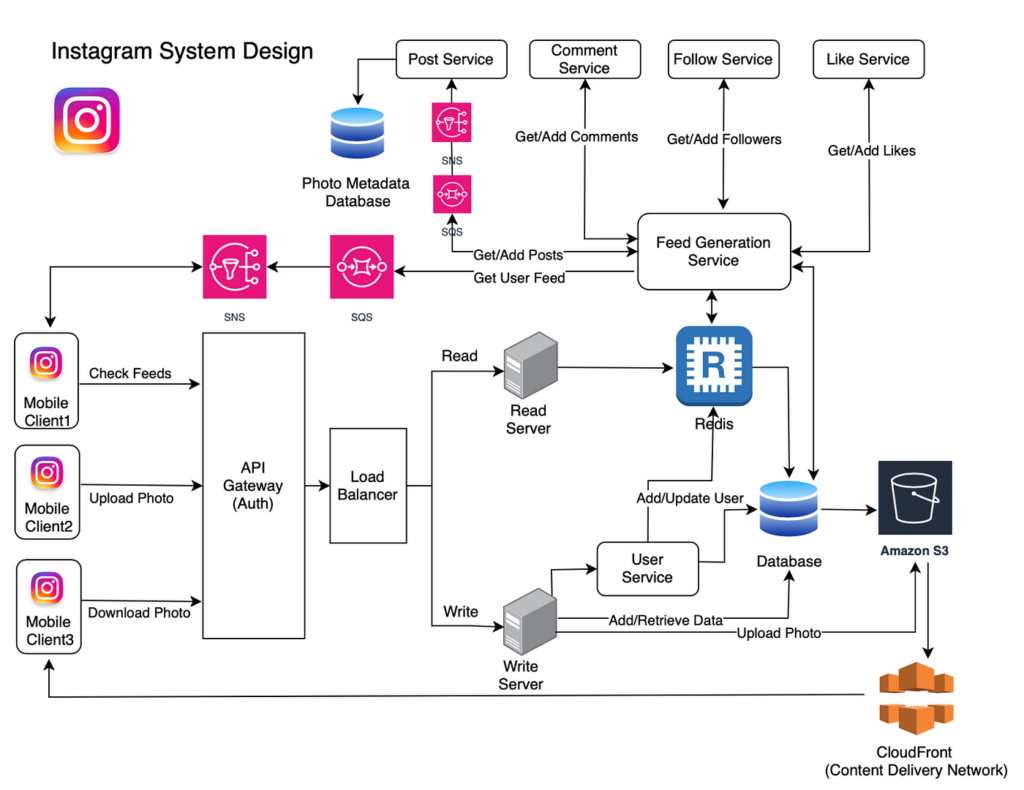From Zero to Billions: How Instagram Scales with Microservices, CDNs, and a Powerful Tech Stack
With over 2 billion active users, Instagram has grown into a digital giant, offering a platform for users to connect, share, and discover content across the globe. Instagram’s journey from a photo-sharing app to a media powerhouse highlights not only strategic growth but also technical excellence. Instagram’s success hinges on its ability to handle vast amounts of data and traffic efficiently. Below, we’ll explore the architecture, tools, and technologies that allow Instagram to manage such a massive scale and remain reliable and innovative.
Instagram began in 2010 as a simple photo-sharing app built with a minimalistic technology stack, primarily using Python and Django on the backend. Over time, as user demands grew and the platform was acquired by Facebook (now Meta), Instagram had to expand its stack with new tools and technologies to support real-time features, machine learning, and vast volumes of media.
Microservices Architecture

At the core of Instagram’s scalability is its microservices architecture. Rather than relying on a monolithic application, Instagram employs a microservices model that breaks the system into discrete, independently deployable services. This architecture allows each service to be managed and scaled individually based on demand, reducing bottlenecks and enhancing resilience. For instance, Instagram can scale its messaging or feed services independently from its search or notification services, ensuring optimal performance and resource allocation.
Microservices also facilitate continuous development and deployment, as engineers can work on individual services without disrupting others. This modularity accelerates Instagram’s ability to introduce new features or update existing ones without affecting the entire platform, supporting both high scalability and reliability.
Global Content Delivery Network (CDN)

With a user base spread across the globe, Instagram relies on a Content Delivery Network (CDN) to ensure quick, reliable access to content. A CDN caches frequently accessed data, such as images, videos, and other media files, at geographically distributed edge servers. By serving content from the nearest edge location to the user, Instagram minimizes latency and provides a faster, smoother experience.
CDNs are particularly crucial for handling peak loads during high-traffic events, like major sporting events or celebrity posts, where demand for specific content can spike dramatically. By offloading static assets to the CDN, Instagram ensures that its core servers remain focused on delivering dynamic content.
Tech Stack Powerhouse

Instagram’s technology stack is a dynamic mix of frontend and backend tools, optimized to handle millions of daily interactions and content uploads. Here’s an overview of the technologies Instagram uses to build and maintain its platform:
Frontend Technologies
- React: Instagram’s user interface is powered by React, a JavaScript library that supports dynamic, interactive UIs. React’s component-based architecture enables efficient rendering of content, an essential feature given the platform’s high volume of user interactions.
- GraphQL: Serving as the API layer, GraphQL allows for efficient querying, giving clients the ability to request specific data fields. This flexibility reduces the amount of data transferred and speeds up the rendering of content on the user interface.
- Swift & Kotlin: For native mobile development, Instagram uses Swift for iOS and Kotlin for Android. These languages allow for optimized, high-performance mobile applications tailored to each platform’s unique features and requirements.
Backend Technologies
- Django: Instagram’s backend is primarily built on Django, a Python-based web framework that provides a robust foundation for handling backend operations. Django’s ORM (Object-Relational Mapping) makes database management and querying efficient and scalable, a necessity for handling billions of interactions.
- Gunicorn: As the web server, Gunicorn serves requests to the Django application, allowing for concurrent processing. Its compatibility with Django and ability to handle multiple requests concurrently makes it a key component in ensuring low-latency responses.
Data Storage Solutions
Instagram’s vast and complex data requirements necessitate a mix of data storage solutions:
- Memcached: This in-memory caching system is used to store frequently accessed data, such as session information, reducing the load on relational and NoSQL databases.
- PostgreSQL: Instagram relies on PostgreSQL as its primary relational database. Known for its reliability and scalability, PostgreSQL handles structured data such as user profiles, interactions, and transactional data.
- Cassandra: As a NoSQL database, Cassandra is used to manage high-volume, non-relational data. This database is particularly useful for storing vast amounts of unstructured data across distributed servers.
- CockroachDB: For distributed SQL needs, CockroachDB provides a highly scalable database solution, allowing Instagram to scale horizontally across multiple data centers seamlessly.
Messaging and Streaming Technologies
Efficient messaging and data streaming are critical for Instagram’s real-time features:
- Apache Kafka: For distributed data streaming, Instagram uses Apache Kafka to handle events and logs in real time. Kafka’s messaging platform is essential for keeping various services synchronized, ensuring that users see the latest updates, notifications, and messages.
- Scuba: Developed internally by Meta, Scuba is a real-time analytics tool that supports internal messaging systems. It allows engineers to query and analyze large datasets in real time, aiding in performance optimization and troubleshooting.
Data Processing and Analytics
Instagram generates immense amounts of data that need to be processed, analyzed, and utilized efficiently:
- Spark: Apache Spark is used for large-scale data processing, helping Instagram handle complex data workflows and perform real-time analytics. Spark’s ability to process data in parallel across clusters makes it ideal for managing Instagram’s massive data load.
- Presto: Presto enables interactive, ad-hoc SQL querying on Instagram’s large datasets. It allows engineers to query data from various sources with low latency, making it a powerful tool for data analysis.
- Scuba: Beyond messaging, Scuba also serves as a data pipeline tool, handling real-time data analytics and providing insights into platform performance and user behavior.
DevOps and Infrastructure Management

To deploy, monitor, and maintain its systems, Instagram uses a variety of DevOps tools that provide efficient resource management and facilitate continuous delivery.
- Kubernetes: Instagram employs Kubernetes for container orchestration, allowing it to automate the deployment, scaling, and operation of containers. Kubernetes is essential for scaling the platform’s infrastructure and enabling smooth, automated failover during high-demand periods.
- Docker: Docker is used for containerization, enabling developers to package applications with all dependencies into isolated environments. This consistency across environments allows for faster testing, development, and deployment.
- ELK Stack: Instagram leverages the ELK Stack (Elasticsearch, Logstash, Kibana) for log management and monitoring. The ELK Stack provides a real-time view of logs, enabling developers to troubleshoot issues quickly and efficiently.
- Prometheus: As a monitoring tool, Prometheus tracks the performance and health of Instagram’s infrastructure, generating alerts and metrics that engineers use to maintain platform reliability.
Ensuring Security and Privacy
With vast amounts of user data, Instagram prioritizes security and employs robust encryption protocols. End-to-end encryption secures private messages, while Transport Layer Security (TLS) protects data during transmission. Additionally, Instagram uses advanced anomaly detection systems and regular security audits to mitigate risks and safeguard user data.
Machine Learning and AI Innovations
Instagram heavily relies on machine learning and artificial intelligence to enhance the user experience, from recommending content to moderating inappropriate content:
- PyTorch: Instagram’s recommendation algorithms and content moderation efforts are powered by PyTorch. This machine learning framework helps Instagram process vast amounts of data, delivering personalized recommendations, ads, and targeted content.
- DeepText: DeepText, Meta’s deep learning-based NLP model, allows Instagram to understand and process text in various languages. It supports content moderation and helps identify inappropriate content or spam.
A Look Ahead: Instagram’s Future Technology Directions
As Instagram continues to grow, its focus remains on expanding its data infrastructure and AI capabilities to enhance the user experience. This involves adopting more sophisticated machine learning algorithms and expanding its distributed database systems. Innovations in augmented reality (AR), real-time 3D rendering, and AI-driven content recommendation will likely play a role in the platform’s future.
Instagram’s robust and resilient technology stack supports a massive user base, handling billions of requests every day with minimal downtime. Its combination of scalable architecture, advanced data processing, and real-time analytics ensures that Instagram remains at the forefront of social media innovation.
